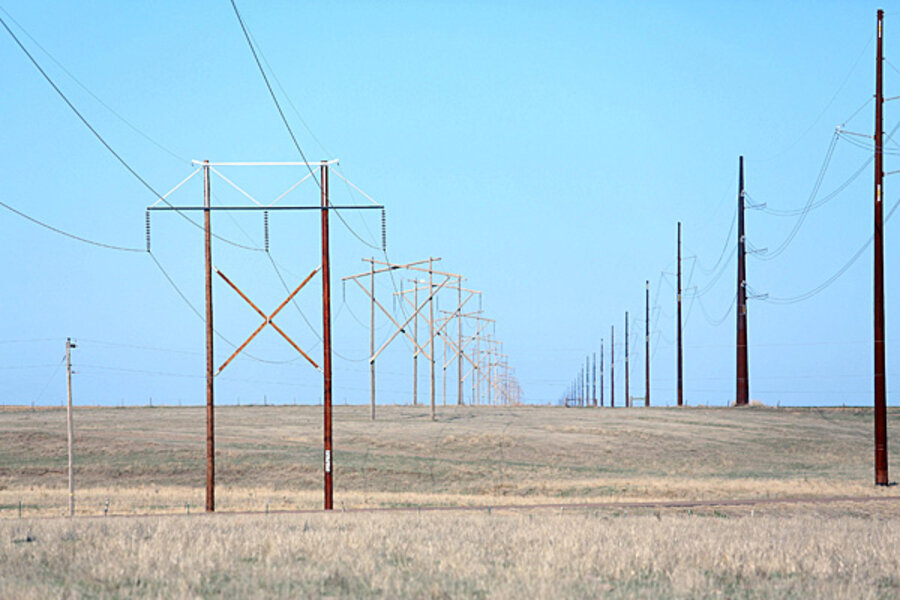In government shutdown, who keeps the lights on?
Loading...
Amid the government shutdown, at least two departments are keeping the lights on – for now.
The US Department of Energy (DOE) and the Federal Energy Regulatory Commission (FERC) continue to operate under "normal conditions" Thursday, according to officials from the two agencies. An extended shutdown, however, would force a reduction of staff at the two agencies that work together to ensure the security and reliability of the nation's electric grid. It's an important task.
"This infrastructure underpins our economy, our quality of life and everything we depend on," Massoud Amin, professor and director of the University of Minnesota's Technological Leadership Institute, said in a telephone interview. "Unfortunately, we often take it for granted and we only notice it when it fails. And we completely forget about it a few months after that failure and move on to the most pressing issues of the day."
State-level commissions and private companies operate the vast majority of the grid's day-to-day operations, but in emergencies and in the long term both federal agencies play an important role. The Energy Department conducts research and offers funding for enhancements to an aging grid. FERC regulates interstate electricity sales, oil pipelines, and energy markets. Both agencies coordinate with the Department of Homeland Security on long-term cybersecurity issues.
That partnership between private industry and public agencies is critical to the medium-term and long-term stability of the nation's electrical grid, Dr. Amin said.
If the shutdown continues, could DOE and FERC successfully protect the nation's grid from internal disruptions and external threats?
"Even if the shutdown extended for some period of time I am absolutely confident the government would step in to make sure funding is available for any kind of critical infrastructure," Mark Weatherford, former deputy under secretary for cybersecurity at the Department of Homeland Security and a principal at security consultancy Chertoff Group. "The utilities could operate without DOE or FERC. They’re going to continue making and delivering kilowatts."
Still some analysts are concerned a shutdown of federal energy agencies would disrupt the federal government's longterm ability to coordinate among the many agencies, commissions, and private companies that keep electricity flowing. And in the event of an emergency, there is some question of how an agency working at limited capacity would respond.
"In day-to-day operation, if there is no major event, we may be OK for a short time," Amin said in a telephone interview, "but if there is an event, like a disaster or attack that needs government assistance and disaster assistance, then the response will require that partnership in full gear."
For now, both DOE and FERC are using carryover funds from previous years to function normally during a lapse of appropriations. But those funds will only last "for a short period" after Sept. 30, according to a DOE official. After that, the agencies will begin to implement their shutdown plans.
“The Administration strongly believes that Congress can quickly come to a resolution to fund the work necessary to American people," a DOE official told the Monitor in an e-mail. "This lapse in appropriations has serious impacts on the Department’s ability to carry out its mission."
Those plans retain essential personnel to "conduct excepted activities to the extent that they protect life and property." That translates to 11 presidential appointees and 937 employees at the Energy Department – 6.8 percent – of its total 13,814 employees. FERC would retain about 3.3 percent of its total 1,460 employees, less exempt presidential appointees.
The DOE's Office of Electricity Delivery and Energy Reliability would retain none of its employees and one presidential appointee. That office is responsible for "leading the Department’s efforts to help ensure that the Nation's electricity delivery system is secure, resilient and reliable."
The office also serves as a liaison to the Department of Homeland Security and FERC on protecting the grid against cyberattacks, natural disasters, and other threats. Each weekday after 5:00 p.m. ET, it publishes the Energy Assurance Daily (EAD), a summary of public information on "developments affecting energy systems, flows, and markets." As of late Thursday afternoon, the Wednesday EAD had not yet been posted to its website.
FERC's shutdown plan lists six activities as essential, including "continued monitoring of the reliability of the bulk power system and threats to energy infrastructures under the Commission’s jurisdiction." That includes real-time operations of the bulk power system and a 24/7 emergency message notification system to alert the five FERC commissioners in the case of emergencies. The plan allocates four employees to this function who "will perform a minimum level of these oversight roles, to monitor for urgent matters."
Of course, none of this directly affects the state and local agencies and nongovernmental organizations that operate the grid. They are the ones that generate and transmit electricity while DOE and FERC monitor, coordinate, regulate, and research.
"FERC itself does not operate the grid," FERC spokeswoman Mary O'Driscoll wrote in an e-mail. "The grid is operated by more than 100 utility owner-operators and regional market operators throughout the country. FERC cannot tell them how to operate the grid on a day to day basis. They operate the grid under mandatory reliability standards established by FERC."
The threat of a shutdown is a learning opportunity for both DOE and FERC to better understand what's essential and what's not for a grid that is aging and evolving, according to Curt Hébert, a visiting scholar at the Bipartisan Policy Center and a former presidential appointee to the Federal Energy Regulatory Commission.
"Let's not forget that one of the things that makes this complex is that you have all these utilities who are trying to work together to keep a certain level of electricity online," Mr. Hébert said in a telephone interview. "There will be a lot to learn from this process."








